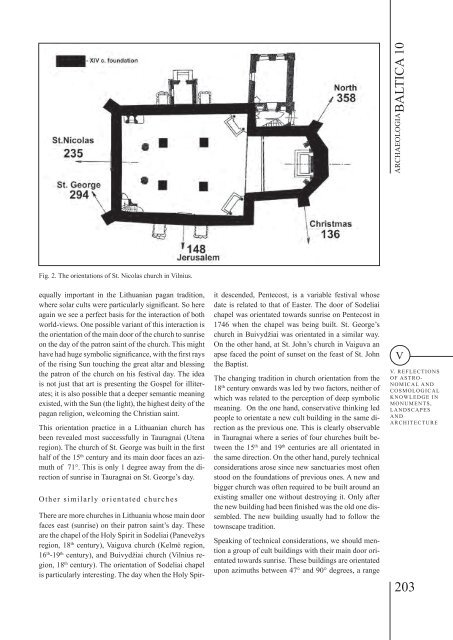BALTICA10
BALTICA10
BALTICA10
You also want an ePaper? Increase the reach of your titles
YUMPU automatically turns print PDFs into web optimized ePapers that Google loves.
ARCHAEOLOGIA BALTICA 10<br />
Fig. 2. The orientations of St. Nicolas church in Vilnius.<br />
equally important in the Lithuanian pagan tradition,<br />
where solar cults were particularly significant. So here<br />
again we see a perfect basis for the interaction of both<br />
world-views. One possible variant of this interaction is<br />
the orientation of the main door of the church to sunrise<br />
on the day of the patron saint of the church. This might<br />
have had huge symbolic significance, with the first rays<br />
of the rising Sun touching the great altar and blessing<br />
the patron of the church on his festival day. The idea<br />
is not just that art is presenting the Gospel for illiterates;<br />
it is also possible that a deeper semantic meaning<br />
existed, with the Sun (the light), the highest deity of the<br />
pagan religion, welcoming the Christian saint.<br />
This orientation practice in a Lithuanian church has<br />
been revealed most successfully in Tauragnai (Utena<br />
region). The church of St. George was built in the first<br />
half of the 15 th century and its main door faces an azimuth<br />
of 71°. This is only 1 degree away from the direction<br />
of sunrise in Tauragnai on St. George’s day.<br />
Other similarly orientated churches<br />
There are more churches in Lithuania whose main door<br />
faces east (sunrise) on their patron saint’s day. These<br />
are the chapel of the Holy Spirit in Sodeliai (Panevežys<br />
region, 18 th century), Vaiguva church (Kelmė region,<br />
16 th -19 th century), and Buivydžiai church (Vilnius region,<br />
18 th century). The orientation of Sodeliai chapel<br />
is particularly interesting. The day when the Holy Spirit<br />
descended, Pentecost, is a variable festival whose<br />
date is related to that of Easter. The door of Sodeliai<br />
chapel was orientated towards sunrise on Pentecost in<br />
1746 when the chapel was being built. St. George’s<br />
church in Buivydžiai was orientated in a similar way.<br />
On the other hand, at St. John’s church in Vaiguva an<br />
apse faced the point of sunset on the feast of St. John<br />
the Baptist.<br />
The changing tradition in church orientation from the<br />
18 th century onwards was led by two factors, neither of<br />
which was related to the perception of deep symbolic<br />
meaning. On the one hand, conservative thinking led<br />
people to orientate a new cult building in the same direction<br />
as the previous one. This is clearly observable<br />
in Tauragnai where a series of four churches built between<br />
the 15 th and 19 th centuries are all orientated in<br />
the same direction. On the other hand, purely technical<br />
considerations arose since new sanctuaries most often<br />
stood on the foundations of previous ones. A new and<br />
bigger church was often required to be built around an<br />
existing smaller one without destroying it. Only after<br />
the new building had been finished was the old one dissembled.<br />
The new building usually had to follow the<br />
townscape tradition.<br />
Speaking of technical considerations, we should mention<br />
a group of cult buildings with their main door orientated<br />
towards sunrise. These buildings are orientated<br />
upon azimuths between 47° and 90° degrees, a range<br />
V<br />
V. REFLECTIONS<br />
OF ASTRO-<br />
NOMICAL AND<br />
COSMOLOGICAL<br />
KNOWLEDGE IN<br />
MONUMENTS,<br />
LANDSCAPES<br />
AND<br />
ARCHITECTURE<br />
203
















